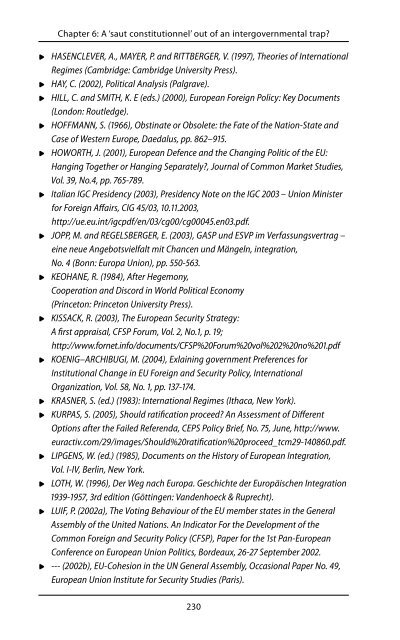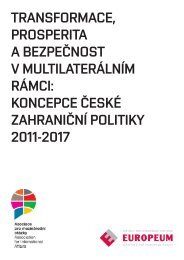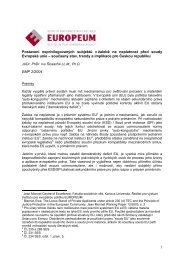eu constitutionalisation - EUROPEUM Institute for European Policy
eu constitutionalisation - EUROPEUM Institute for European Policy
eu constitutionalisation - EUROPEUM Institute for European Policy
Create successful ePaper yourself
Turn your PDF publications into a flip-book with our unique Google optimized e-Paper software.
Chapter 6: A ‘saut constitutionnel’ out of an intergovernmental trap?g HASENCLEVER, A., MAYER, P. and RITTBERGER, V. (1997), Theories of InternationalRegimes (Cambridge: Cambridge University Press).g HAY, C. (2002), Political Analysis (Palgrave).g HILL, C. and SMITH, K. E (eds.) (2000), <strong>European</strong> Foreign <strong>Policy</strong>: Key Documents(London: Routledge).g HOFFMANN, S. (1966), Obstinate or Obsolete: the Fate of the Nation-State andCase of Western Europe, Daedalus, pp. 862–915.g HOWORTH, J. (2001), <strong>European</strong> Defence and the Changing Politic of the EU:Hanging Together or Hanging Separately?, Journal of Common Market Studies,Vol. 39, No.4, pp. 765-789.g Italian IGC Presidency (2003), Presidency Note on the IGC 2003 – Union Minister<strong>for</strong> Foreign Affairs, CIG 45/03, 10.11.2003,http://ue.<strong>eu</strong>.int/igcpdf/en/03/cg00/cg00045.en03.pdf.g JOPP, M. and REGELSBERGER, E. (2003), GASP und ESVP im Verfassungsvertrag –eine n<strong>eu</strong>e Angebotsvielfalt mit Chancen und Mängeln, integration,No. 4 (Bonn: Europa Union), pp. 550-563.g KEOHANE, R. (1984), After Hegemony,Cooperation and Discord in World Political Economy(Princeton: Princeton University Press).g KISSACK, R. (2003), The <strong>European</strong> Security Strategy:A first appraisal, CFSP Forum, Vol. 2, No.1, p. 19;http://www.<strong>for</strong>net.info/documents/CFSP%20Forum%20vol%202%20no%201.pdfg KOENIG–ARCHIBUGI, M. (2004), Exlaining government Preferences <strong>for</strong>Institutional Change in EU Foreign and Security <strong>Policy</strong>, InternationalOrganization, Vol. 58, No. 1, pp. 137-174.g KRASNER, S. (ed.) (1983): International Regimes (Ithaca, New York).g KURPAS, S. (2005), Should ratification proceed? An Assessment of DifferentOptions after the Failed Referenda, CEPS <strong>Policy</strong> Brief, No. 75, June, http://www.<strong>eu</strong>ractiv.com/29/images/Should%20ratification%20proceed_tcm29-140860.pdf.g LIPGENS, W. (ed.) (1985), Documents on the History of <strong>European</strong> Integration,Vol. I-IV, Berlin, New York.g LOTH, W. (1996), Der Weg nach Europa. Geschichte der Europäischen Integration1939-1957, 3rd edition (Göttingen: Vandenhoeck & Ruprecht).g LUIF, P. (2002a), The Voting Behaviour of the EU member states in the GeneralAssembly of the United Nations. An Indicator For the Development of theCommon Foreign and Security <strong>Policy</strong> (CFSP), Paper <strong>for</strong> the 1st Pan-<strong>European</strong>Conference on <strong>European</strong> Union Politics, Bordeaux, 26-27 September 2002.g --- (2002b), EU-Cohesion in the UN General Assembly, Occasional Paper No. 49,<strong>European</strong> Union <strong>Institute</strong> <strong>for</strong> Security Studies (Paris).Chapter 6: A ‘saut constitutionnel’ out of an intergovernmental trap?g MARCH, J. and OLSEN, J. (1989), Rediscovering Institutions, The OrganizationalBasis of Politics (New York, London: Free Press).g MAURER, A. and WESSELS, W. (2003), The <strong>European</strong> Union matters: structuringself-made offers and demands, in: Wessels, Wolfgang/ Maurer, Andreas/Mittag, Jürgen: Fifteen into one? The <strong>European</strong> Union and its member states(Manchester, New York: Manchester University Press), pp. 29-65.g MAURER, A. and WESSELS, W. (2001), National Parliaments on their Waysto Europe. Losers or Latecomers?, Schriften des Zentrum für EuropäischeIntegrations<strong>for</strong>schung (Baden-Baden: Nomos).g MEYER, C. (2004), The Soft Side of Hard <strong>Policy</strong> Co-ordination in EMU: PeerPressure and Publicised Opinion in Germany and Ireland, Journal of <strong>European</strong>Public <strong>Policy</strong>, Vol. 11, No. 5, pp. 822-839.g MORAVCSIK, A. (1993), Preferences and Power in the <strong>European</strong> Community,A Liberal Intergovernmental Approach, Journal of Common Market Studies,Vol. 31, pp. 437-524.g --- (2002), The quiet superpower, Newsweek 17 June 2002, Atlantic Edition.g MONAR, J. (1997), The <strong>European</strong> Union’s Foreign Affairs System after the Treatyof Amsterdam. A Strengthened Capacity <strong>for</strong> External Action?, <strong>European</strong> ForeignAffairs Review, No. 2, pp. 413-436.g NIEDERMAYER, O. (2003), Die öffentliche Meinung zur zukünftigen Gestalt der EU(Bonn: Europa Union Verlag).g NUTTALL, S. (1992), <strong>European</strong> Political Cooperation, Ox<strong>for</strong>d.g OLSEN, J. (2002): The many Faces of <strong>European</strong>ization,ARENA Working Papers WP 01/2.g OLSEN, J. (2003), Re<strong>for</strong>ming <strong>European</strong> Institutions of Governance, in: Weiler,Joseph H.H./ Begg, Ian/ Peterson, John (eds.): Integration in an Expanding<strong>European</strong> Union. Reassessing the Fundamentals (Ox<strong>for</strong>d), pp. 45-65.g PIERSON, P. (1996), The Path to <strong>European</strong> Integration: A Historical InstitutionalistAnalysis, Comparative Political Studies, Vol. 19, No. 2, pp. 123-163.g PLEUGER, G. (2002), Double Hat, Working Group VII on External Action, Workingdocument 17, 5.11.2002, http://<strong>eu</strong>ropean-convention.<strong>eu</strong>.int/docs/wd7/4484.pdf.g REGELSBERGER, E. (2004), Die Gemeinsame Außen- und Sicherheitspolitik der EU(GASP). Konstitutionelle Angebote im Praxistest 1993 – 2003 (Baden-Baden: Nomos).g REGELSBERGER, E. and WESSELS, W. (2005): The Evolution of the CommonForeign and Security <strong>Policy</strong>. A Case of an Imperfect Ratchet Fusion, in: Verdun,Amy/ Croci, M. (eds.), The <strong>European</strong> Union in the wake of Eastern enlargement.Institutional and policy-making challenges (Manchester University Press).g RISSE, T. (2003), Social Constructivism and <strong>European</strong> Integration, in: Wiener, Antje/ Diez,Thomas (2003), Theories of <strong>European</strong> Integration: Past, Present and Future (Ox<strong>for</strong>d).230231








